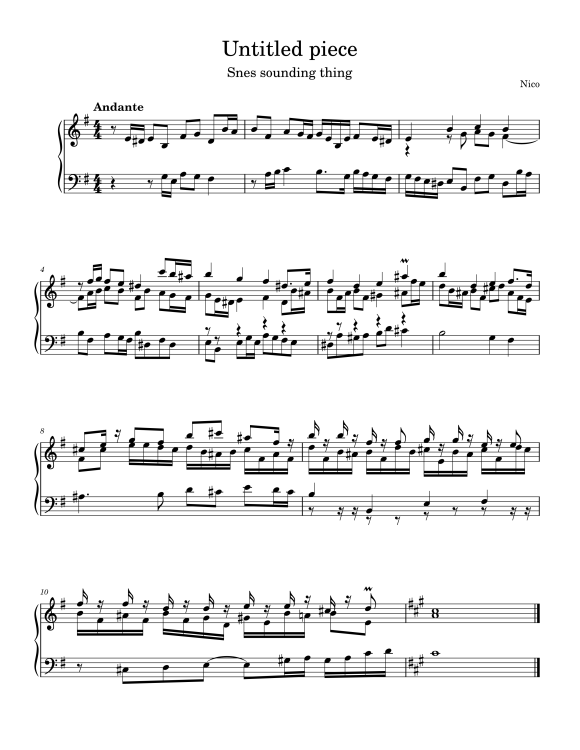All Activity
- Past hour
-
Hello @Fausto Manuel Orieta, Welcome to the forum! I think this one is enjoyable to listen to, even though it’s more in Baroque style’s counterpoint than Fux’s species counterpoint. Like that you try imitation in b.53. Although I find it a bit deliberate with the do re mi / mi re do moves throughout the movement. Also I think you can add some slur markings even this means to be a Baroque piece. I would personally prevent those augmented second movement of the violin (F-G#) near the end since it sounds a bit out of style. Thx for joining and sharing! Henry
-
Hi @Churchcantor, Welcome to the forum! I only listen to the first movement and I quite like the modulation you have in the movement. For me maybe you can add more moments when the piano carry the melody and the violin can sometimes play the accompaniment. Also, slurs for the violin would be essential! Dynamic details and phrasings are also crucial in both parts! Thx for joining and sharing. Henry
-
Hello @90110n, Welcome to the forum! I don’t listen to the original at all. Lemme just respond point by point: The key signature is perfectly fine here with just some F sharps for the Dorian mode. I do find the key change in b.127 unnecessary since you are modulating to G/E minor anyway later. I don’t think ninths are unplayable by vast majority of pianists at all. From what I see from your score an intermediate level pianist will be able to play your score so it’s perfectly playable. What is the bar number of the bridges? For me the dissonance here is absolutely fine. I would keep it as it is, and it’s nice you have the sense to avoid repetition for the choruses! For me some of the bars with bare chords like b.65 or 165 too bare. Probably you can add more harmonic notes for fuller chords there. Thx for sharing and joining! Henry
-
You didn’t write a septuple fugue as I suggested haha. I like the eerie feeling the microtones brought but at the same time it follows a strict fugal procedure so sounds even more eerie to me. Nice job and thx for sharing! Henry
- Today
-
I've been studying counterpoint for years now, learned mainly from Fux's gradus and developed a solid understanding of species counterpoint. That said, one quick analysis of this first movement will reveal deviations from the rules presented in that book. Accented passing notes, leaping from dissonances, and the occasional unprepared chord in second inversion, that one consecutive fifth... I'm well aware of the rules broken and the liberties I have taken when it came time to make the transition from species exercises to actual composition. Despite that, i'm very proud with what I ended up with. There's plenty that I wish to improve, and hopefully you'll get to hear the results of my efforts in the following 2 movements, as well as in everything that will be released following the completion of this sonata. Youtube link with sidescrolling score:
-
Fausto Manuel Orieta changed their profile photo
-
Fausto Manuel Orieta joined the community
-
Henry Ng Tsz Kiu started following Lava Cave - Microtonal VGM
-
.thumb.png.8b5b433a341551e913a34392660bc95b.png)
Lava Cave - Microtonal VGM
PeterthePapercomPoser replied to PeterthePapercomPoser's topic in Incidental Music and Soundtracks
Thanks! I considered doubling the melody with Violins but in the end I decided to let the Distorted guitar shine on it's own. You gotta imagine the sound of the bubbling of the lava inside of a sub-glacial volcano! LoL -
chopin started following Lava Cave - Microtonal VGM
-
Lava Cave - Microtonal VGM
chopin replied to PeterthePapercomPoser's topic in Incidental Music and Soundtracks
I think the microtones in this case make the soundtrack more dramatic, which makes sense if this is for a lava cave. Also, nice use of repetition, adding to the ominous atmosphere. Fun melody from the electric guitar that would work well in an RPG. The only thing I may add is that, if this is going to repeat or loop for a game, maybe consider an instrument that isn't as harsh on the ears...although it probably depends on the sound samples you go for. -
PeterthePapercomPoser started following A Cradle Song - Prologue (SATB + Piano) and Lava Cave - Microtonal VGM
-
I've finally gotten around to writing some of the kind of music I've been dreaming of - microtonal video-game music! This is for a hypothetical video game that I might make myself some time in the future. I thought that microtones would lend themselves very well to creating the kinds of moods necessary for video games, especially RPG's (which is the kind of game I want to make). This particular track is meant for a lava cave type of level. The instrumentation is 2 Oboes, 2 Bassoons, French Horn, Timpani, Bass Drum, Synthesizer, Electric Distorted Guitar, Violins, Violas, Cellos and Basses. The tuning is 24 TET and I pick and choose occasional sub-minor 3rds, super-major 3rds, as well as super-major 6ths and near-tritone intervals. I'd appreciate any kind of suggestion, critique, comment or observation you may have. Thanks for listening!
- Yesterday
-
Henry Ng Tsz Kiu started following A Cradle Song - Prologue (SATB + Piano)
-
seo_composer started following A Cradle Song - Prologue (SATB + Piano)
-
Hello! This is my first post here and I wanted to share a piece of music that I finished last year. The "A Cradle Song" work is a collection of pieces using the popular poem "A Cradle Song," by William Blake. This setting of the first stanza is the prologue to the entire journey through the poem. I wanted to capture a sense of a sweet and wondrous in the beginning that introduces theme of the work. I also wanted to simulate the feeling of a warm hug--almost as though one can feel the cradle of a baby in their caregiver's arms. The warmth becomes a beam of joy and curiosity as the voices reach up to starts like moony beams. However, where we arrive still leaves a question at the end for what lies ahead. As this is the prologue, it is the shortest piece of the bunch. With all that said, I wish you a wonderful listening experience and any feedback is appreciated.
-
- choir
- contemporary music
-
(and 2 more)
Tagged with:
-
chadbach joined the community
-
Piano Concerto
Valerio DallaRagione replied to Valerio DallaRagione's topic in Orchestral and Large Ensemble
Hi Frank! Thank you very much for your kind and supporting words. Regards - Last week
-
But I'm thinking about it! It will probably be clearer that I copy here a translation of the text. It is not easy to read the translation on the Youtube video on the fly. SOLO DE LUNE (after Jules Laforgue) I smoke, sprawled under the sky, On the roof of the stagecoach. My body jolts, my soul is dancing, Like some Ariel. No honey, no bitterness — my soul is dancing. O roads, hills, smoke and valleys, My dear soul — let’s recall a few things. — Her eyes said: “Do you understand? Why don’t you understand?” — O cool woods along the road, O shawl of sadness, Every soul listens a little, And my life must seem lovely! This stagecoach roof Feels like something enchanted. — Her eyes blinked: “Do you understand? Why don’t you understand?” — O moon solo, You defy my pen. O stars, you’re almost frightening, You’re all here! every one! O how brief this hour is! If only there were a way To keep its soul for the autumn to come. — Ah! Why didn’t I fall at your knees? I would have been the model husband — Like the rustle of your dress is the model of all rustles.
-
chopin started following Microtonal Fugue in A
-
Microtones work a lot better with strings because it just makes it sounds like the performers are slurring their notes. Funny how the whole piece is this eerie mood (bec of the microtones), but then you end in a major key. I love the part from 0:44 to 0:47. It's beautiful to my ears! Well done, you're nailing microtones in a way that makes the listening a fun experience.
-
shirz joined the community
-
A soundtrack idea of mine for exploring a haunted abandoned theme park where the ghosts have unfinished business (probably related to the theme park being abandoned) and you're looking for clues to uncover the story of the theme park... This is mostly a piano rendition, although I imagine the song having organs and strings. But I haven't gotten around to doing it yet... https://soundcloud.com/sheeye/remainders-of-the-fun-we-had?ref=clipboard&p=a&c=1&si=79ddede14a264ba09c51b5f61e3a2635&utm_source=clipboard&utm_medium=text&utm_campaign=social_sharing
-
Thank you so much! It’s truly rewarding to feel heard — even in the smallest details — especially when working in French, which isn’t always the easiest language to share online. I’m really glad it resonated with you. Laforgue offers us a message of lost love — cruel, universal, and timeless.
-
Haha, you’re absolutely right — it would definitely save me a fair amount of pencil lead! The reason I generally avoid using key signatures is that I don’t want to feel boxed into a tonal framework while composing. I need to be able to escape at any moment. (Even though in this case, the harmony remains fairly traditional — if slightly wobbly at times…) I’m also a bit wary of giving the performer the “harmonic solution” upfront — sometimes there are several, and it’s up to them to choose what feels most appropriate. So yes, I tend to approach the page as a blank, open space. Most of my manuscripts are working drafts anyway — I really should take the time to clean them up. And when I do, using key signatures might actually be a sensible option. 😉 As for the reference to Dichterliebe — thank you! That cycle has been with me forever… It’s sort of my singer’s Bible, you know. So yes, there may well be echoes of it in what I write — intentional or not. The coda of Dichterliebe is such a marvel — a very strange and beautiful thing — like a page gently closing, a consolation, the dream-kiss of a beloved. We are, after all, speaking of bitterness and love… so of course, we’re already halfway into that world. In any case, thank you for your listening and your advice.
-
Hi guys! The past three weeks I've struggled coming up with something decent and finally came up with this about half an hour ago. It's a SNES/polyphonic sort of track (not sure how else to describe it), since I like that timbre. I'm not sure how to approach that major key I end up in, should I continue that or switch it to a minor one to keep the "dark" sound? Poly SNES.mp3
-
Nico_ joined the community
-
Hi @Henry Ng Tsz Kiu! Wonderful and simple use of secondary dominants and classic sequences. The melodicity of the piece is also more defined and the pastorale nature of it is more solidified with the birdsong allusions. But it has its Sturm und Drang moments to it as well as the occasional random pauses before the birdsong gets its solo moment which is really a great way to emphasize that aspect of the composition. You underline the birdsong by exposing it in solo relief - very clever. Lately every piece I've heard from you has been getting better and better. And imo this whole sonata is an even more substantial achievement than your sextet! Great job and thanks for sharing!
-
seo_composer joined the community
-
Tritones in scales, yes, but look at the left hand and what I am doing with ye old Church Modes, including Locrian...which the piece is in! Tritone for a dominant.
-
It's hardly my best piece, and the repeats are there because it is an ETUDE. Doubt it would be anyone's favorite piece! Anyone who cares to perform it, however, is welcome to leave out the repeats.
-
I guess the point is not that there shouldn't be repeats, but that they should still serve to move the narrative forward. Da capo aria? The first time the performer introduces the material, the second time they are encouraged to make it their own with ornaments or other small changes. But for this exercise, the structure of what you were doing with tritones and scales is firm enough that there isn't much room for experimentation or nuance when it's played through again. Welcome to the forums! And I disagree! If you're alive, you are getting exposed to new musical ideas and influences which are sure to keep you growing. Cheers.
-
Well, not really commenting on my own pieces, unless I have to, but thanks anyway. I use repeats, sure; so did Mozart! Good enough for me. I've been writing music for 38 years, and won't get any better at it than I already am.
-
Hello @Churchcantor and welcome to the forum! I've noticed that you posted a large number of your pieces already, sometimes commenting on your own topics multiple times. There's a few reasons why you should avoid doing that. 1) Posting too many works in a short time tends to overwhelm the members and reviewers on the site and they might not pay as much attention to your work as if you posted one work at a time. 2) Commenting on your own topic before anyone else has had a chance to reply also makes it look like people have already replied to your work in the "List of works with few reviews". If a piece has more than 5 reviews it gets removed from the list even if all the replies are just you replying to your own topic. This piece has a very clever name given that it explores the use of parallel tritones! Cool idea! I think calling it an "experimental etude" is a really good description! But some etudes, besides being exercises in some kind of theoretical construct (in this case the parallel tritones and also some surprising use of polyrhythm) also manage to be musical and entertaining. What with all the heavy chords and copious use of repeats this piece gets really tiresome to listen to even once (I also can't identify a reason why the repeats should be there). I can't identify a melody or some kind of musical hook to get me to tune into it on more than a surface level. There's also no dynamic contrast or balance between different elements of the composition, some of which could be more important than others. It's a cool experiment though! Thanks for sharing.
-
Nice Rag, and Joplin would love it! I've played with the idea of writing a Rag in the style of Scott Joplin, and calling it "Maple's Grease Rag," but haven't gotten around to it. I use ragtime form, AABBACCDD, in some of my rondos.






